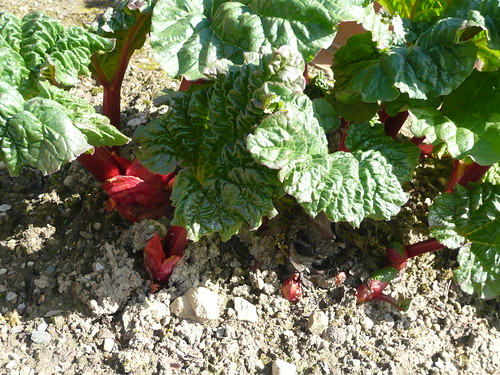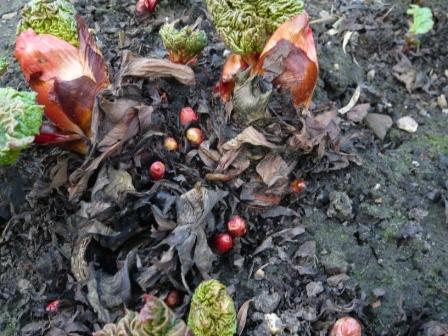Help Growing Rhubarb
If you want to help your Rhubarb water it even when it is raining!

Rhubarb Summary Top Tips
- Encourage strong leaf growth to encourage heavy crops with nitrogen compost and manure. Lime in winter.
- Stop picking stems by the end of July to allow roots to boost strength for next season.
- Plant 3 feet apart in friable but well trodden soil.
- Give a thick mulch around clumps to preserve moisture.
Rhubarb Calendar
- Plant out new roots with good eyes/buds in November or December.
- Divide roots in October-December a large 3 year old root may produce 6 plants/offsets.
- Allow all leaves to die down in autumn before clearing away.
- Grow from fresh seed sown under cover in September or direct in March
- Pick early, second early or Late maturing varieties from March to August.
- Grow your own Rhubarb as it is easy to cultivate and gives a large crop of tender pink stalks.
- Avoid picking stalks in the first year – let the crowns develop.
Varieties to choose
- Victoria, with thin stalks of rosy red that turn pink and green towards the tip. It is a late season cropper.
- Timperley Early AGM is the earliest to be harvested with long stems and a good flavour.
- Raspberry Red is a mid-late season variety of deep red stalks.
- Stocksbridge Arrow, is an old favourite in the West Riding of Yorkshire the home of there rhubarb triangle.
- Champagne is also one of the best varieties but there are lots to choose from at your garden centre or cadge a crown from neighbours.
Grow Rhubarb without fuss
- One or two plants will produce ‘fruit’ for many pies and crumbles about 5 lbs per plant- water the plants in dry conditions and pick after the first full season has been allowed to put energy into the root system.
- Every 5 years or when the plant becomes unproductive lift and split the root with a budded crown on each piece and replant
- Rhubarb likes slightly acid soil but tolerates most soil with good drainage and a high humus content
- Do not let the plants flower or energy will not go into stalk production. Cut flowers off as soon as possible.
- Rhubarb is tough and likes a frost to encourage growth
- Thin tender pink stalks can be forced early by placing a pot or barrel over the plant
- Do not eat the leaves they contain Oxalic acid.
Organic Rhubarb
- However the leaves can be composted as the acid breaks down
- Grow rhubarb organically as chemicals may react to the leaves.
- There aren’t many predators until the slugs come as the leaves decompose
The crown of the plant is the top of the root system where the stalks shoot from. Under the crown will be a thick root r rhizome with finer hairs to take up the nutrients from the soil. Because it produces a large crop it needs feeding with good compost or farmyard manure when planted and then as a mulch every spring and autumn.
My last post alluded to the green shoots of economic recovery, well all I can now say is Rhubarb Rhubarb. This is a clump of my Rhubarb waiting to joins other stalks in a crumble or pie.
Growing Rhubarb to Eat
- The stalks are the only part to be eaten, the leaves are full of poisonous Oxalic acid.
- Rhubarb is a vegetable but despite or because of its tart flavour it is mainly eaten with sugar as a sweet.
- Rhubarb like a bit of winter frost to encourage growth.
- Forcing Rhubarb by covering to make dark warm conditions will produce early, thin, tender stalks. Only force the plant in alternate years to avoid weakening the crown.
- Cropping between April to June when little else is available this is an undemanding and easy to cultivate plant
- The flowers are borne on hollow stalks and a a greyish white. I pull them out to conserve the plants strength.
Rheums are not just Rhubarb link
Planting and growing Rhubarb
Buy Rhubarb from Thompson & Morgan

3 thoughts on “Help Growing Rhubarb”
Comments are closed.